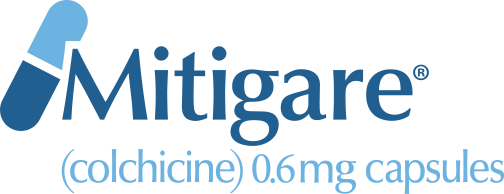
Whether you grow old gracefully or fight it every step of the way, one thing is for sure—aging is inevitable. But what about aging with gout? If you have gout, you might wonder how getting older will impact the disease and your risk of gout attacks. Maybe you worry gout could increase your risk of developing other chronic conditions. If you have gout, you probably also want to know what you can do to stay healthy and avoid complications as you age. Read on to learn more about aging with gout.
Uric acid and gout
The root cause of gout (which happens to be the most common form of inflammatory arthritis) is excess uric acid.1 Uric acid can build up in the bloodstream when the body makes too much of it or cannot get rid of enough of it (or both).1 After the uric acid level has remained high for a long time, urate crystals can begin to form around a joint, often the big toe.1 These crystals can cause sudden episodes of intense pain, redness and swelling in a joint.1 These episodes are known as gout attacks or gout flares.1
Gout in older adults
Hyperuricemia, which is the medical term for having a high level of uric acid in your body, is common (about 1 in 5 people have it).2 Men are about 4 times more likely to develop gout than women.2 With age, however, gout becomes more common in both genders.1-3 Researchers believe that estrogen may help prevent the development of gout in younger women.4 Once menopause occurs and the estrogen level starts to decline, however, a woman’s risk of developing gout can increase.4 Urate concentrations tend to go up as a person gets older, so gout may worsen with age.3
The four stages of gout
According to the Arthritis Foundation, there are four stages of gout:5
Asymptomatic Gout—Uric acid slowly builds in the bloodstream until it reaches an abnormally high level.5 Without a blood test, however, a person with asymptomatic gout may have no idea that they could be at risk for a gout flare.2
Acute Gout—The excess uric acid in the bloodstream begins to form urate crystals in the spaces around a joint (for many people, the first joint affected is in the big toe).1,5 When these crystals are disturbed, they can cause a gout attack.1
Intercritical or Interval Gout—Once that first gout flare is over, a person may not experience another one for months or even years.5 However, uric acid can continue to accumulate in the bloodstream and urate crystals can continue to form in the joints—even when gout attacks are not occurring.5
Chronic Tophaceous Gout—If uric acid levels are not well controlled, gout can progress to this final and most advanced stage.5 In chronic tophaceous gout, the urate crystals around a joint can become large and may form bumps or nodules that are visible under the skin.5 These lumps, called tophi, can eventually cause physical changes and restrict movement.5
The best thing you can do for your gout is manage it and prevent the progression of the disease.5 Thanks to effective treatments, many people with gout never reach the most severe stages.5
Chronic conditions associated with gout
Sudden, excruciatingly painful gout flares can be distressing and disruptive.3 The threat of these attacks may not be the worst thing about having gout, however.3 People with gout are more likely to suffer with other serious and chronic conditions than those who do not have gout, and the risk of developing these conditions increases with age.3 Among them are type 2 diabetes, high blood pressure and abnormally high cholesterol/lipid levels.3 Kidney damage and disease can also occur.3
Comprehensive gout management is needed
Although there is no cure for gout, it can be effectively managed with medication, lifestyle changes and regular medical care.6,7
Medication—Upon diagnosing you with gout, your doctor will probably prescribe a urate-lowering therapy (ULT) such as allopurinol to help limit the amount of uric acid your body makes and reduce your risk of gout flares.7 Your doctor may also recommend a colchicine product such as Mitigare® (Colchicine) 0.6mg Capsules to prevent flares, especially when you first begin treatment with a ULT.8-10
Lifestyle Changes—Although medications often are the most effective way to manage gout, your lifestyle choices are important as well.11 Eat a healthy, well-balanced diet that includes lean meats, fruits, vegetables and whole grains.12 Drink plenty of water and avoid alcohol.12 Lose weight if you need to, and get regular exercise.11
Doctor Visits—If you have gout, it’s important to visit your primary care doctor every 6 months so you can update him or her on your gout symptoms and have your uric acid level measured.7 If your gout is more severe or you continue to suffer from frequent flares, your primary care doctor may refer you to a rheumatologist or another health care provider who specializes in gout management.13
Mitigare® is a registered trademark of Hikma Pharmaceuticals USA Inc.
Colchicine 0.6 mg capsules are contraindicated in patients with renal or hepatic impairment who are currently prescribed drugs that inhibit both P-gp and CYP3A4. Combining these dual inhibitors with colchicine in patients with renal or hepatic impairment has resulted in life-threatening or fatal colchicine toxicity. Patients with both renal and hepatic impairment should not be given Mitigare®.
Fatal overdoses have been reported with colchicine in adults and children. Keep Mitigare® out of the reach of children.
Blood dyscrasias such as myelosuppression, leukopenia, granulocytopenia, thrombocytopenia and aplastic anemia have been reported with colchicine used in therapeutic doses.
Monitor for toxicity and, if present, consider temporary interruption or discontinuation of colchicine.
Drug interaction with dual P-gp and CYP3A4 inhibitors: Co-administration of colchicine with dual P-gp and CYP3A4 inhibitors has resulted in life-threatening interactions and death.
Neuromuscular toxicity and rhabdomyolysis may occur with chronic treatment with colchicine in therapeutic doses, especially in combination with other drugs known to cause this effect. Patients with impaired renal function and elderly patients (including those with normal renal and hepatic function) are at increased risk. Consider temporary interruption or discontinuation of Mitigare®.
The most commonly reported adverse reactions with colchicine are gastrointestinal symptoms, including diarrhea, nausea, vomiting and abdominal pain.
Please see the full Prescribing Information and Medication Guide for Mitigare® for complete product details.
NOTE: This article was not written by a medical professional and is not intended to substitute for the guidance of a physician. These are not Hikma’s recommendations for gout flare prevention, but rather facts and data collected from various reliable medical sources. For a full list of resources and their attributing links, see below.
